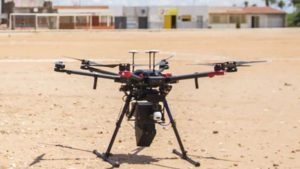
The International Atomic Energy Agency (IAEA) announced this week the successful testing of a drone-based effort to sterilize mosquitoes in an effort to stop the spread of the deadly Zika virus.
In cooperation with the United Nations’ Food and Agriculture Organization, the IAEA and Swiss-American non-profit WeRobotics developed a UAV solution to release the airborne Sterile Insect Technique, a kind of “insect birth control” that deploys radiation to sterilize male mosquitoes.
“The release mechanism for mosquitos has until now been a bottleneck in the application of SIT to control human diseases,” said Jeremy Bouyer, medical entomologist at the Joint FAO/IAEA Division of Nuclear Techniques in Food and Agriculture. “The use of drones is a breakthrough, and paves the way for large-scale and cost-efficient releases, also over densely populated areas.”
WeRobotics is a “team of entrepreneurs, drone adventurers and humanitarians bringing robotics technology to communities for social good.”
“The biggest challenge in designing this mechanism was keeping the mosquitos healthy and competitive while transporting and releasing them at cool temperatures” said Adam Klaptocz, co-founder of WeRobotics. “We’re pleased with initial tests that show less than 10 per cent mortality through the entire chilling, transport and aerial release process.”
Researchers will next try to slim down the drone to increase carrying capacity to 150,000 mosquitoes per flight.
“With the drone, we can treat 20 hectares in five minutes,” said Bouyer. “Weighing less than 10 kilograms, the drone can carry 50,000 sterile mosquitos per flight. At 10,000 Euro per drone, its use also reduces the cost of releasing mosquitos by half.”
“We are hopeful about the application of SIT for the control of Aedes aegypti in Brazil with the results from the drone tests,” said Jair Virginio, Director of Brazil-based Moscamed, a recently-designated IAEA Collaborating Centre.
WeRobotics deploys “Flying Labs” around the world — collaborative institutions designed to share technology that empowers humanitarian projects in such places as Peru where drones deliver medical supplies to regions around the Amazon River.
Jason is a longstanding contributor to DroneLife with an avid interest in all things tech. He focuses on anti-drone technologies and the public safety sector; police, fire, and search and rescue.
Beginning his career as a journalist in 1996, Jason has since written and edited thousands of engaging news articles, blog posts, press releases and online content.
Email Jason
TWITTER:@JasonPReagan
Subscribe to DroneLife here.